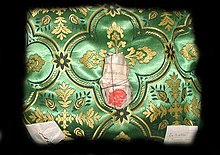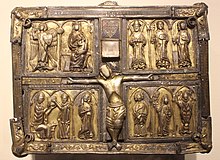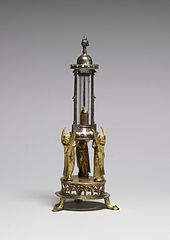Reliquary


A reliquary (also referred to as a shrine, by the French term châsse, and historically also a type of phylactery[1]) is a container for relics. A portable reliquary may be called a fereter, and a chapel in which it is housed a feretory or feretery.[2]
Relics have long been important to Buddhists, Christians, Hindus, and to followers of many other religions.[3][4][5] These cultures often display reliquaries in shrines, churches, or temples to which the faithful make pilgrimages to gain blessings.
The term is sometimes used loosely for containers for the body parts of non-religious figures; in particular, the
In Christianity


The use of reliquaries became an important part of
The relics were enshrined in containers crafted of or covered with gold, silver, gems, and enamel.[6] Ivory was widely used in the Middle Ages for reliquaries; its pure white color is an indication of the holy status of its contents.[7] These objects constituted a major form of artistic production across Europe and Byzantium throughout the Middle Ages.
Many were designed with portability in mind, often being exhibited in public or carried in
Sixteenth-century reformers such as
Forms

The earliest reliquaries were essentially boxes, either simply box-shaped or based on an architectural design, taking the form of a model of a church with a pitched roof. These latter are known by the French term
Relics of the True Cross became very popular from the 9th century onward and were housed in magnificent gold and silver cross-shaped reliquaries decorated with enamels and precious stones. From about the end of the 10th century, reliquaries in the shape of the relics they housed also became popular; hence, for instance, the skull of Pope Alexander I was housed in a head-shaped reliquary. Similarly, the bones of saints were often housed in reliquaries that recalled the shape of the original body part, such as an arm or a foot.
Many
A philatory is a transparent reliquary designed to contain and exhibit the
During the later Middle Ages, the monstrance form, primarily used for consecrated hosts, was sometimes used for reliquaries. These housed the relic in a rock crystal, or glass capsule mounted on a column above a base, enabling the relic to be displayed to the faithful. Reliquaries in the form of large pieces of metalwork jewellery also appeared around this time, housing tiny relics such as pieces of the Holy Thorn, notably the Holy Thorn Reliquary now in the British Museum.
In Buddhism

In Buddhism,
Two famous very early excavated reliquaries are the 1st-century
In Buddhism, relics are known as cetiya; one of the most significant is the relic of the tooth of the Buddha in Sri Lanka. In Japan, Buddhist relics are known as shari (舎利, śarīra), and are often stored in a shariden (舎利殿, relic hall, reliquary). (See also: Japanese Buddhist architecture)
See also
References
- OCLC 8182124165.
- ^ "feretery". Oxford English Dictionary (Online ed.). Oxford University Press. (Subscription or participating institution membership required.)
- ^ "Two Gandhāran Reliquaries". K. Walton Dobbins. East and West, 18 (1968), pp. 151–162.
- ^ The Stūpa and Vihāra of Kanishka I. K. Walton Dobbins. (1971). The Asiatic Society of Bengal Monograph Series, Vol. XVIII. Calcutta.
- ^ "Is the Kaniṣka Reliquary a work from Mathurā?" Mirella Levi d’Ancona. Art Bulletin, Vol. 31, No. 4 (Dec. 1949), pp. 321–323.
- ^ a b Boehm, Barbara Drake. "Relics and Reliquaries in Medieval Christianity". In Heilbrunn Timeline of Art History. New York: The Metropolitan Museum of Art,(October 2001)
- ^ Speakman, Naomi C., "Treasures of Heaven", The British Museum, London, 2011
- ^ Tomov, Nikola; Dzhangozov, Januarius (Yanko). "Wax Embedding as a Method for Preservation of Body Relics Used by the Orthodox Church" (PDF). Acta Morphologica et Anthropologica. 25 (1–2): 122–125.
Further reading
- Bynum, Caroline Walker; Gerson, Paula (January 1997). "Body-Part Reliquaries and Body Parts in the Middle Ages". Gesta. 36 (1): 3–7. doi:10.2307/767274.
- Hahn, Cynthia (January 1997). "The Voices of the Saints: Speaking Reliquaries". Gesta. 36 (1): 20–31. doi:10.2307/767276.
- ISBN 9780870991790
External links
 Media related to Reliquaries at Wikimedia Commons
Media related to Reliquaries at Wikimedia Commons


